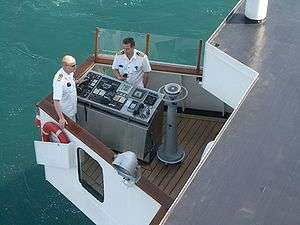Flying bridge
A flying bridge is an open area on top of a surface ship that provides unobstructed views of the fore, aft, and the sides of a vessel,[1][2] and that serves as an operating station for the ship's officers, such as the captain or officer of the watch.[2]

Surface vessels
Prior to World War II, virtually every sailing ship, steamship, monitor, paddle steamer, or large pleasure ship had a flying bridge above the pilot house or main bridge.[2] Flying bridges were generally not enclosed at all (although sometimes they were partially enclosed), and often had little equipment—usually just a speaking tube or telephone to allow communication with the helmsman or wheelman on the main bridge.[2] On military warships after 1914, the flying bridge was usually the station for the air defense officer and the gunnery officer.[3] The amount of equipment on a flying bridge varies widely with the need of the captain. During World War II, for example, American submarine chaser surface ships had a well-outfitted flying bridge which usually contained a pelorus, signal lamps, telescope, and voice tube to permit the captain to command the ship.[4] U.S. Navy attack transport ships could be outfitted with either 20mm or 40mm automatic cannons on their flying bridges.[5]
Flying bridges were almost always the highest bridge on the ship.[1] They usually were above the flag bridge (also known as the "admiral's bridge")[note 1] and the main bridge.[3]
Some flying bridges have "bridge wings", open areas which thrust outward from the flying bridge over the sides of the vessel by approximately 10 to 15 feet (3.0 to 4.6 m) to allow an officer to see the side of his ship while docking or working with smaller vessels.[2]
Since the 1980s, large pleasure craft may have a flying bridge[6] toward the stern that is used as additional outdoor seating space and a place to store a tender.[7] On the smallest surface vessels, such as a sport fishing boat, the flying bridge may have controls permitting the ship to be piloted from the flying bridge, but will lack the full range of controls of the pilot house. On larger small vessels, the flying bridge may actually be enclosed, in which case it is more properly called an "upper pilot house" or "upper bridge".[3]
Submarines
On a submarine, the flying bridge is usually called "the bridge". It is the highest point on the conning tower, to provide for better visual navigation when on the surface.[3] They became standard on United States Navy submarines after 1917, and greatly improved the function of the ships while at the surface.[8]
Notes
- This was a bridge above the main bridge on a command warship where a high-ranking officer such as an admiral could conduct fleet operations, plan strategy, and conduct large battles.
References
- Curley, Stephen J. The Ship That Would Not Die: USS Queens, SS Excambion, and USTS Texas Clipper. College Station, Tex.: Texas A&M University Press, 2011, p. 81.
- Thompson, Mark L. Queen of the Lakes. Detroit: Wayne State University Press, 1994, p. 123.
- Lenfestey, Tom. The Sailor's Illustrated Dictionary. New York: Lyons Press, 2001, p. 173.
- Jones. H.G. The Sonarman's War: A Memoir of Submarine Chasing and Mine Sweeping in World War II. Jefferson, N.C.: McFarland & Co., 2010, p. 29.
- Friedman, Norman. U.S. Amphibious Ships and Craft: An Illustrated Design History. Annapolis, Md.: Naval Institute Press, 2002, p. 39, 60.
- "Flybridge". mBoat.eu. 2020-06-19.
- "Pilothouse Motoryacht". Boating. May 2006. p. 66. Retrieved 19 May 2013.
- Friedman, Norman. U.S. Submarines Through 1945: An Illustrated Design History. Annapolis, Md.: Naval Institute Press, 1995, p. 35.